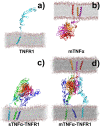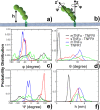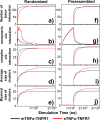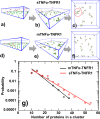Understanding the functional role of membrane confinements in TNF-mediated signaling by multiscale simulations
- PMID: 35277586
- PMCID: PMC8917213
- DOI: 10.1038/s42003-022-03179-1
Understanding the functional role of membrane confinements in TNF-mediated signaling by multiscale simulations
Abstract
The interaction between TNFα and TNFR1 is essential in maintaining tissue development and immune responses. While TNFR1 is a cell surface receptor, TNFα exists in both soluble and membrane-bound forms. Interestingly, it was found that the activation of TNFR1-mediated signaling pathways is preferentially through the soluble form of TNFα, which can also induce the clustering of TNFR1 on plasma membrane of living cells. We developed a multiscale simulation framework to compare receptor clustering induced by soluble and membrane-bound ligands. Comparing with the freely diffusive soluble ligands, we hypothesize that the conformational dynamics of membrane-bound ligands are restricted, which affects the clustering of ligand-receptor complexes at cell-cell interfaces. Our simulation revealed that only small clusters can form if TNFα is bound on cell surface. In contrast, the clustering triggered by soluble TNFα is more dynamic, and the size of clusters is statistically larger. We therefore demonstrated the impact of membrane-bound ligand on dynamics of receptor clustering. Moreover, considering that larger TNFα-TNFR1 clusters is more likely to provide spatial platform for downstream signaling pathway, our studies offer new mechanistic insights about why the activation of TNFR1-mediated signaling pathways is not preferred by membrane-bound form of TNFα.
© 2022. The Author(s).
Conflict of interest statement
The authors declare no competing interests.
Figures






Similar articles
-
How does the same ligand activate signaling of different receptors in TNFR superfamily: a computational study.J Cell Commun Signal. 2023 Sep;17(3):657-671. doi: 10.1007/s12079-022-00701-2. Epub 2022 Sep 28. J Cell Commun Signal. 2023. PMID: 36167956 Free PMC article.
-
Computational simulations of TNF receptor oligomerization on plasma membrane.Proteins. 2020 May;88(5):698-709. doi: 10.1002/prot.25854. Epub 2019 Nov 18. Proteins. 2020. PMID: 31710744 Free PMC article.
-
A multiscale study on the mechanisms of spatial organization in ligand-receptor interactions on cell surfaces.Comput Struct Biotechnol J. 2021 Mar 23;19:1620-1634. doi: 10.1016/j.csbj.2021.03.024. eCollection 2021. Comput Struct Biotechnol J. 2021. PMID: 33868599 Free PMC article.
-
Selective Modulation of TNF-TNFRs Signaling: Insights for Multiple Sclerosis Treatment.Front Immunol. 2018 Apr 30;9:925. doi: 10.3389/fimmu.2018.00925. eCollection 2018. Front Immunol. 2018. PMID: 29760711 Free PMC article. Review.
-
Analyzing for co-localization of proteins at a cell membrane.Curr Pharm Biotechnol. 2004 Apr;5(2):213-20. doi: 10.2174/1389201043376931. Curr Pharm Biotechnol. 2004. PMID: 15078156 Review.
Cited by
-
Extracellular Vesicle-Associated TWEAK Contributes to Vascular Inflammation and Remodeling During Acute Cellular Rejection.JACC Basic Transl Sci. 2023 Jan 11;8(5):439-456. doi: 10.1016/j.jacbts.2022.09.014. eCollection 2023 May. JACC Basic Transl Sci. 2023. PMID: 37325400 Free PMC article.
-
How does the same ligand activate signaling of different receptors in TNFR superfamily: a computational study.J Cell Commun Signal. 2023 Sep;17(3):657-671. doi: 10.1007/s12079-022-00701-2. Epub 2022 Sep 28. J Cell Commun Signal. 2023. PMID: 36167956 Free PMC article.
-
Apoptotic signaling by TNFR1 is inhibited by the α2-6 sialylation, but not α2-3 sialylation, of the TNFR1 N-glycans.J Biol Chem. 2025 Jan;301(1):108043. doi: 10.1016/j.jbc.2024.108043. Epub 2024 Nov 29. J Biol Chem. 2025. PMID: 39615678 Free PMC article.
-
The Role of TNF-α in Alzheimer's Disease: A Narrative Review.Cells. 2023 Dec 26;13(1):54. doi: 10.3390/cells13010054. Cells. 2023. PMID: 38201258 Free PMC article. Review.
-
Exploring the role of macromolecular crowding and TNFR1 in cell volume control.Elife. 2024 Sep 19;13:e92719. doi: 10.7554/eLife.92719. Elife. 2024. PMID: 39297502 Free PMC article.
References
-
- Dostert C, Grusdat M, Letellier E, Brenner D. The TNF family of ligands and receptors: communication modules in the immune system and beyond. Physiol. Rev. 2019;99:115–160. - PubMed
-
- Locksley RM, Killeen N, Lenardo MJ. The TNF and TNF receptor superfamilies: integrating mammalian biology. Cell. 2001;104:487–501. - PubMed
Publication types
MeSH terms
Substances
Grants and funding
LinkOut - more resources
Full Text Sources

